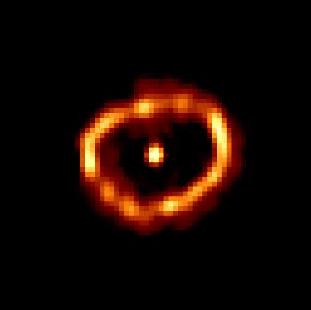

The picture above is Nova Cygni 1992, taken 2 years after it exploded from the Hubble Space Telescope.
Some stars that have exploded, for example Nova Cygni 1992 and E0102-72 have a ring around it. The formation of this ring is due to the collision of particles at the equatorial plane of the star. If the trajectory of a particle from the northern hemisphere crosses the equatorial plane, by symmetry, it will collide with a particle from the opposite hemisphere having a mirrored image trajectory.
Consider a particle on the surface of a rotating star of radius ro having an angle θ with the polar axis. Based on observation of sunspots, we can assume that prior to the star exploding, the particle is confined to a fixed latitude. In the figure below, plane AA' represents this fixed latitude.
If the star rotates with an angular velocity ωo, the particle at the surface at a distance of ro sin θ from the polar axis will have an initial velocity prior to the explosion, Vp given by:
| Vp = ωo ro sin θ eΦ | (i) |
eΦ is the azimuthal unit vector. In the figure above, the particle denoted by P can be imagined to be moving out of the paper (or out of your screen if you are reading this from your PC!). Both AA' and BB' are planes normal to this figure.
Let's assume that after the star explodes, the trajectory of a particle from the surface depends only on its momentum and the star's gravitational field. In other words, after the explosion, it becomes a 'ballistic particle'.
As the surface explodes outward, the particle from the surface acquires a velocity component in the radial direction. For the particle P, if we sum up the the vectors representing the initial velocity prior to the explosion (Vp), and a radial component (Vo) outward, the resultant vector for velocity of ejecta (VE) would be:
| VE= ωo ro sin θ eΦ + Vo er | (ii) |
er is the radial unit vector. After being ejected from the surface of the star, this ballistic particle would be attraced toward the centre of gravity, which is the centre of the star. The plane BBí consists of both the centre of gravity and the vector VE.
The particle will be confined to this plane until it collides with another particle or is attracted by the gravitational field of some other object not in this plane. Every different particle on the surface that is ejected has a different trajectory associated with it; thus in spherical coordinates the plane BB' depends on the angle 'θ' and Φ.
Now consider the trajectory of another particle at the surface with a polar angle π - θ and the same azimuthal angle Φ. Letís call the plane of this mirror imaged trajectory as CC'.
The line intersecting planes BB' and CC' passes through the origin and is on equatorial plane of the star. If the centre of the star is denoted as O, the line OP makes 90į with this intersecting line. This proves that P and P' might collide at the equatorial plane.
To answer this question, we need to look at the trajectory of the particle as seen on plane BB'. It is known that using Newtonís laws, the path of a ballistic object would either be a circle, ellipse, parabola or hyberbola. If the path is a parabola or hyperbola, the particle will never reach the equatorial plane.
After the explosion, the angular momentum of the particle at the surface having a polar angle θ , (per unit mass with respect to centre of the star), h is given by
| h ( θ ) = ro2 ωo sin θ | (iii) |
The energy of the particle per unit mass, E is given by the sum of its kinetic and potential energy.
| E ( θ ) = (vo2 + ro2 ωo2 sin 2 θ )/2 - GM/ro | (iv) |
Letís use (ρ,φ) to denote the position of the particle on plane B-B' in polar coordinates. The equations conserving energy (E) and angular momentum (h) per unit mass are:
| E = ( (dρ/dt)2 + ρ2 (dφ/dt)2 ) /2 - GM/ρ | (v) |
| h = ρ2 (dφ/dt) | (vi) |
E and h would depend on the angle that the plane B-B' is inclined to the rotation axis of the star (θ) as given in equations (iii) and (iv). Eliminating t from (v) and (vi), the trajectory is
| ρ = (h2/GM) / (1 - e sin (φ + α)) | (vii) |
where α is an arbitrary constant of integration that is equal to zero if the apogee is chosen to be at φ = π/2 as shown above and e, the eccentricity is given by
| e = √ (1 + 2Eh2/G2M2) | (viii) |
For the trajectory to be an ellipse, the eccentricity must be between 0 and 1, i.e. when E satisfies the following:
| -G2M2/2h2 < E < 0 | (ix) |
3 Hints: (i) There were 3 bright sources observed. (ii) There were 3 peaks in its light curve. (iii) There were 3 light echoes.